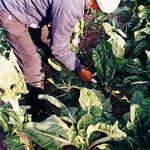| Fruits |
Vegetables
|
Chard, Beta vulgaris var. cycla / Chenopodiaceae
|
Note: Composition for 100 g. of fresh product Values in ( min. - max. ) format. | |
| Energy: 21.00-21.00 kcal Fats: 0.4 g Fibres: 5.6 g Minerals Calcium: 47.00-47.00 mgZinc: 0.02 mg Phosporus: 34.00-34.00 mg Iron: 1.10-1.10 mg Magnesium: 71 mg Potasium: 550 mg Iodine: 35 µg | Proteins: 3.50-3.50 kcal Carbohidrates: 1.80-1.80 g Liposoluble Vitamins A Carotenoids: 2025.00-2025.00 µgLiposoluble Vitamins B1 or Thiamine: 0.066-0.066 mgB2 or Riboflavine: 0.084-0.084 mg B3 or Niacine: 1.80-1.80 mg B9 or Folic Acid: 6.00-6.00 mg C or Ascorbic Acid: 6.00-6.00 mg |
|
Note: Composition for 100 g. of fresh product Values in ( min. - max. ) format. | |
| Energy: 1 kcal Fats: 4 g Fibres: 5 g Fat Acids Saturated: 6 gMonounsat.: 7 g Polyunsat.: 8 g Minerals Calcium: 20 mgZinc: 27 mg Chlorine: 24 mg Phosporus: 21 mg Iron: 26 mg Magnesium: 22 mg Manganese: 31 mg Potasium: 25 mg Selenium: 29 µg Sodium: 23 mg Iodine: 28 µg | Proteins: 3 kcal Carbohidrates: 2 g Liposoluble Vitamins A Retinol: 9 µgA Carotenoids: 10 µg E or Tocoferol: 11 mg K or Filoquinone: 12 µg Liposoluble Vitamins B1 or Thiamine: 13 mgB2 or Riboflavine: 14 mg B3 or Niacine: 15 mg B5 or Pantothenic Acid: 16 mg B9 or Folic Acid: 19 mg C or Ascorbic Acid: 19 mg |

The chard is a plant with large green leaves and fleshy white stalks, used for human nutrition.
It is usually eaten cooked and seasoned like boiled food, or as meat or fish garnish. Its taste is similar to that of spinach but somewhat smoother.
It is usually eaten cooked and seasoned like boiled food, or as meat or fish garnish. Its taste is similar to that of spinach but somewhat smoother.
Nutrition and eating
The chard has multiple medicinal and nutritional applications. If it is eaten in salads, with lemon juice, it fortifies the stomach and invigorates the brain; it helps to make the nerves go down. To treat gall stone, drink a glass of chard juice and watercress juice in equal parts before eating.
The fruit
 The chard(Beta vulgaris var. cicla) is a plant with large green leaves and fleshy white stalks, used for human nutrition.
The chard(Beta vulgaris var. cicla) is a plant with large green leaves and fleshy white stalks, used for human nutrition. It is usually eaten cooked and seasoned like boiled food, or as meat or fish garnish. Its taste is similar to that of spinach but somewhat smoother.
As with the rest of vegetables, it is recommended to consume it as soon as possible, since it looses nutritious properties soon after harvesting. It is kept in the fridge for no more than 4 days; storage conditions improve if we introduce the unwashed leaves in a perforated plastic bag.
Its nutritious composition for each 100 g of fresh produce is: water 91.1%, fats 0.3%g, fibre 0.8 g, iron 3.2 mg, calcium 88 mg, vitamin A 6,500 UI, vitamin C 3.2 mg. It is a laxative and digestive plant; it is one of the richest vegetables in calcium after spinach.
They are sold in the markets all over the year and they are found fresh or frozen. The best units are those with smooth, bright and uniform green-coloured leaves. The stalks must be hard and of a white colour. They are highly recommended in slimming diets since they represent a very low caloric supply. However, people suffering from gall or kidney stones must limit the consumption of this vegetable, since they contain high levels of oxalates.
Exports in most places insignificant. In Spain, some years ago, the value was relatively important and the vegetable was mainly destined to France.
The plant

Biennial long day plant belonging to the chenopodiaceous family. Its botanical name is Beta vulgaris var. cicla.
When the temperatures are high and the days are longer than 12 hours, the plant may end its cycle in few months, so it loses all its commercial value since it bears the flower.
Quite deep and fibrous root. Large, oval to heart-shaped leaves. Wide and long petiole (stalk) extending to the limb and forming the edible part of the vegetable. The colour varies according to the varieties, from dark green to pale green.
During the second year it bears the flower thalamus, extremely branched, flowers provided with a crescent calyx giving rise to a multiple fruit in glomerules. Two or three flowers are included in a single fruit.
The seed is polygermic and, therefore, each one bears 2 or 3 plants. Approximately 4 years of germination power.
When the temperatures are high and the days are longer than 12 hours, the plant may end its cycle in few months, so it loses all its commercial value since it bears the flower.
Quite deep and fibrous root. Large, oval to heart-shaped leaves. Wide and long petiole (stalk) extending to the limb and forming the edible part of the vegetable. The colour varies according to the varieties, from dark green to pale green.
During the second year it bears the flower thalamus, extremely branched, flowers provided with a crescent calyx giving rise to a multiple fruit in glomerules. Two or three flowers are included in a single fruit.
The seed is polygermic and, therefore, each one bears 2 or 3 plants. Approximately 4 years of germination power.
| Interempresas Media, S.L. / 2026 | [ Legal notice | Política de Protección de Datos | Política de cookies | Publicidad] |
